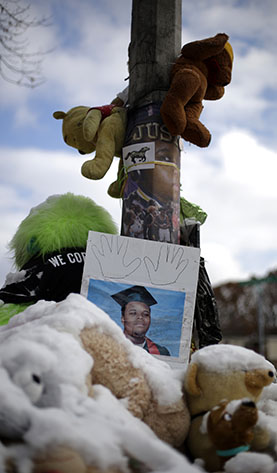St. Louis students and administrators come to agreement
November 20, 2014

A high school graduation photo of Michael Brown rests on top of a snow-covered memorial Monday, Nov. 17, 2014, more than three months after the black teen was shot and killed nearby by a white policeman in Ferguson, Mo. The shooting sparked weeks of violent protests and Missouri Governor Jay Nixon declaring a state of emergency today as a grand jury deliberates on whether to charge Ferguson police officer Darren Wilson in the death.
With tensions high in the St. Louis area over the pending grand jury decision for indicting Darren Wilson, a series of weeklong demonstrations and protests at St. Louis University aimed to restore some peace to the community.
Held from Oct. 13 to Oct. 18, the protests were spurred by the death of Michael Brown and the subsequent death of Vonderrit Myers, who was also fatally shot by an unnamed officer during an armed altercation. Students at the university were greeted with rallies and tents as groups gathered near the school’s clock tower. The movement came to be known as OccupySLU.
Jonathan Pulphus, African-American studies sophomore at SLU, said the demonstrations had a strong presence on campus.
“For a casual observer, you no longer became casual. No matter what was on your mind when you woke up that morning or what was due that day, or what your responsibilities as a student, as a community member or whatever, seeing this in the middle of campus made you curious,” Pulphus said.
There were three organizations that spearheaded the protests: the Black Student Alliance, the Metropolitan St. Louis Coalition for Inclusion and Equality, also known as M-SLICE, and Tribe X.
Tribe X came into existence during the demonstrations, involving some members from M-SLICE, but its mission focuses more on and involves more of the college population in the St. Louis area.
Alisha Sonnier, vice president of Tribe X and SLU biological engineering freshman, said the organization started as a collaborative effort between students and other community members.
“Then they finally said ‘Let’s form an organization where we can actually do the change and challenge this on a more public, organized and structured platform,” Sonnier said about community members.
Throughout the protests, Pulphus and Sonnier also interacted with administrators at the school whom they said they had mostly positive interactions with.
Pulphus said that Tribe X members were invited to speak to various classes at the university.
“Real recognize real, they saw what we were doing and knew the potential backlash,”Pulphus said.
The three groups decided to gather protesters on the campus, which is less than two miles away from the neighborhood where Myers’ death occurred on Oct. 8.
“I thought why not St. Louis University,” Sonnier said. “I’m a student at this institution that’s based in St. Louis City. I’m a student at an institution where an incident happened maybe ten blocks away.”
One week after the OccupySLU movement began, Tribe X, BSA and M-SLICE were able to gain some concessions from the administration at SLU.
Assistant Vice President of Communication for SLU Clayton Berry said that negotiations “were both candid and collegial.”
“We would take exception with the term ‘concessions,’ however,” Berry said. “We believe we reached an accord that is consistent with and will help further our Jesuit mission.”
Pulphus said that the school originally provided “one to two” of the concessions provided in the final letter and that the trifecta of organizations leading the protests had to negotiate with the school for much of what was in the letter.
“All of that came about because there were things that the university had already been told to do for years and decades that it needed to happen,” Pulphus said.
Berry said that some of the items in the agreement were suggested by University President Fred Pestello.
Many of the concessions were aimed at improving the African-American community in the St. Louis area and for African-American students currently attending SLU. The concessions were delivered in letter form with a signature from Pestello.
In a letter addressing SLU on Oct. 22, Pestello said he felt the protests were a positive event for the school, “moving our campus forward to address some of the keys social issues brought forward last week.”
Moving forward, Sonnier said she does not believe that the grand jury decision will end the activism.
“Regardless of whether or not an indictment is released, Tribe X is going to continue to take a stance on issues and take a stand on things that allow a Mike Brown case to happen. Period,” Sonnier said.
Berry said that even though there is no indication that any unrest will occur on the campus, the university has taken steps to prepare “because we believe we have a responsibility to be prepared for any situation.”
The agreed upon items can be found on St. Louis University’s website.






